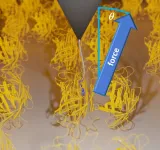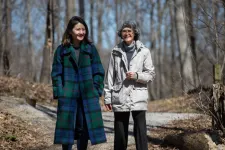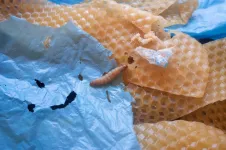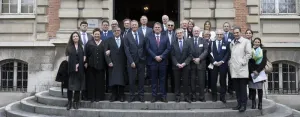(Press-News.org) An interdisciplinary research team of the Institutes of Physical Chemistry and Physics of the University of Freiburg and the Max Planck Institute of Biophysics in Frankfurt-am-Main has discovered a new, direction-dependent friction in proteins called anisotropic friction. “Until now, nobody had observed that friction in biomolecules was dependent on direction,” says physicist Dr. Steffen Wolf of the University of Freiburg. The results have been published as cover story in the scientific journal “Nano Letters.”
Experiments on model complex of protein-ligands
Proteins constitute the microscopic machinery of cells. They perform work during their functional cycles. Accordingly, they follow the laws of thermodynamics, exhibit an energy conversion efficiency, and lose energy during their functional cycle due to dissipation. From a macroscopic perspective, the latter effect corresponds to apparent friction. On the microscopic scale of single proteins, a known source of friction is internal friction of proteins that results from the excitation of protein-internal vibrations. A further source is solvent friction, which arises from the acceleration of surrounding solvent molecules. These sources of friction lead to heating of both protein and solvent. Here, the researchers discovered the novel type of friction by carrying out single molecule experiments and simulations on a model complex of a protein and a ligand.
In their single molecule experiments, the team used a new method applying stereographic single molecule force spectroscopy, which is based on atomic force microscopy (AFM). This technique allowed them to study the unbinding of a ligand from a protein bound to a surface not only along a single coordinate, but along all three Cartesian coordinates. During their experiments, Dr. Wanhao Cai, Prof. Dr. Thorsten Hugel and Dr. Bizan N. Balzer of the Institute of Physical Chemistry of the University of Freiburg as well as Dr. Jakob T. Bullerjahn of the Max Planck Institute, made the surprising discovery that friction during ligand unbinding increases with the pulling angle applied.
Combining experiment and computer simulations
Miriam Jäger and Dr. Steffen Wolf of the University of Freiburg’s Institute of Physics subsequently recreated the experiment using computer simulations. They used the high performance computing (HPC) resources of the BinAC-HPC-Cluster in Tübingen. During the simulations they determined that the work of detaching a ligand from its binding site depends on the exact direction of application of the pulling force.
By combining results from the experiment and simulations, the researchers recognized that the source of the angle-dependent friction is the undefinable and random orientation of the proteins along their rotational axes bound to the surface in the experiment. The team repeated the single molecule pulling experiments by binding and unbinding a ligand to and from a protein many times in order to achieve statistically significant results. There, the ligand binds to a different protein for each measurement. Consequently, in each measurement, a ligand was pulled at the same angle with respect to the surface, but over different regions of the randomly-oriented protein. This orientation cannot be defined, both in the experimental setup and in the real world, and each measurement cannot be exactly and reversibly repeated. Therefore, each time different amounts of energy were deposited into the biomolecule. The irreversible part of this energy was lost as heat to the system. The corresponding effect is a source of friction, which the researchers call anisotropic friction.
A fundamental type of friction
“We assume that this previously unknown and fundamental type of friction is present in every bioassembly in which randomness in protein orientation appears together with directionality of force application,” says Dr. Bizan N. Balzer, a biophysicist. He explains that this is the case in biomolecular motors or force-sensitive membrane proteins, as well as for processes such as blood flow, where forces are exerted on randomly oriented proteins. Balzer concludes, “Anisotropic friction is thus another important piece of the puzzle for understanding friction in both technical applications and in biological complexes in general.”
Factual overview:
Original publication: Cai, W., Jäger, M., Bullerjahn, J. T., Hugel, T., Wolf, S., Balzer, B. N.: Anisotropic Friction in a Ligand-Protein Complex. In: Nano Letters 2023. DOI: http://doi.org/10.1021/acs.nanolett.2c04632.
Thorsten Hugel is a professor, Bizan N. Balzer a lecturer and Wanhao Cai a post-doctoral researcher at the Institute of Physical Chemistry of the University of Freiburg. Hugel and Balzer are members of the Excellence Cluster “Living Adaptive and Energy-autonomous Materials Systems” (livMatS) of the University of Freiburg. Balzer is a member of the Freiburg Materials Research Center (FMF). Steffen Wolf is a lecturer, and Miriam Jäger a doctoral candidate, at the Institute of Physics at the University of Freiburg. They are members of the Research Unit FOR5099 of the German Research Foundation (DFG) “Reducing complexity of nonequilibrium systems.” Jakob T. Bullerjahn is a staff researcher at the Max Planck Institute of Biophysics in Frankfurt-am-Main.
The German Research Foundation (DFG) is supporting their research through the project HU 997/13-1, the excellence initiative − EXC-2193/1 − 390951807 and the project WO 2410/2-1 within the Research Unit FOR5099 “Reducing complexity of nonequilibrium systems” (project no. 431 945 604) and the project INST 37/935-1 FUGG, as well as the Max Planck Society. Furthermore, the work is being supported by the bwUniCluster-Computing-Initiative, the High Performance/Cloud Computing Group at the Center for Data Processing at the University of Tübingen as well as the state of Baden-Württemberg through bwHPC.
Contact:
University and Scientific Communications
University of Freiburg
Tel.: 0761/203-4302
E-Mail: kommunikation@zv.uni-freiburg.de
END
New type of friction discovered in ligand-protein systems
2023-03-31
ELSE PRESS RELEASES FROM THIS DATE:
New UNC Chapel Hill study quantifies $562M in financial risk from Hurricane Florence using novel modeling approach that evaluates risk of mortgage default and property abandonment
2023-03-31
When Hurricane Florence made landfall on North Carolina’s coast in 2018, it brought record rainfall causing catastrophic flooding and damages to communities across the eastern portion of the state.
Estimating the financial impacts of household flooding is complex because direct damages often snowball into other financial risks, like a decrease in property value or loss of equity. Generally, post-disaster damage assessments focus on insured and uninsured losses, but these numbers do not account for the secondary impacts to households, lenders, local governments and other stakeholders who may also share in the financial consequences if a property owner defaults ...
What is foreign exchange market or simply Forex?
2023-03-31
The Forex market, also known as the foreign exchange market or simply Forex (short for "foreign exchange"), is a decentralized global market where various currencies are traded. It is the largest financial market in the world, with a daily trading volume exceeding $6 trillion. The primary purpose of the Forex market is to facilitate international trade and investment by allowing businesses, governments, and individuals to convert one currency into another.
Can cities make room for woodpeckers?
2023-03-31
Researchers are deploying the latest mapping techniques to identify the most important suburban habitat for North America’s largest woodpecker.
University of Cincinnati doctoral student Ruijia Hu said wildlife habitat in congested places like southwest Ohio is becoming increasingly fragmented as forests give way to new construction. Eventually, this could spell trouble to an animal with specific habitat needs like Ohio’s pileated woodpecker.
Pileated woodpeckers are crow-sized birds with colorful red crests and striking white facial stripes. They are found in forests from British Columbia to Florida. They have the ...
Study: ChatGPT has potential to help cirrhosis, liver cancer patients
2023-03-31
A new study by Cedars-Sinai investigators describes how ChatGPT, an artificial intelligence (AI) chatbot, may help improve health outcomes for patients with cirrhosis and liver cancer by providing easy-to-understand information about basic knowledge, lifestyle and treatments for these conditions.
The findings, published in the peer-reviewed journal Clinical and Molecular Hepatology, highlights the AI system’s potential to play a role in clinical practice.
“Patients with cirrhosis and/or liver cancer and their caregivers often have unmet needs and insufficient knowledge about managing and preventing complications of their disease,” ...
A healthy microbiome may prevent deadly infections in critically ill people
2023-03-31
Twenty to 50 per cent of all critically ill patients contract potentially deadly infections during their stay in the intensive care unit or in hospital after being in the ICU – markedly increasing the risk of death.
“Despite the use of antibiotics, hospital-acquired infections are a major clinical problem that persists to be a huge issue for which we don’t have good solutions,” says Dr. Braedon McDonald, MD, PhD, an intensive care physician at the Foothills Medical Centre (FMC) and assistant professor at the ...
Academic institutions receive lower financial returns from biotechnology licenses than commercial firms
2023-03-31
BENTLEY UNIVERSITY
The financial terms of biotechnology licenses from academic institutions are significantly less favorable than those of comparable licenses between commercial firms according to a new study from Bentley University’s Center for Integration of Science and Industry. The study, published in the journal PLOS ONE, shows that the royalties and payments to academic institutions are significantly lower than those to commercial firms for similar licenses and products at the same stages of development.
The article, titled “Comparing the economic terms of biotechnology licenses from academic institutions with those ...
Harnessing nature to promote planetary sustainability
2023-03-31
As Earth’s population grows, the demands of modern lifestyles place mounting strain on the global environment. Proposed solutions to preserve and promote planetary sustainability can sometimes prove more harmful than helpful. However, technologies that harness natural processes could be more successful.
Such technologies are the focus of the latest issue of the open access journal PLOS Biology, which features a special collection publishing March 31st of papers highlighting biology-based solutions that could be applied to reduce carbon dioxide emissions, eliminate non-degradable plastics, produce food or energy ...
Study examines how social rank affects response to stress
2023-03-31
Can an individual’s social status have an impact on their level of stress? Researchers at Tulane University put that question to the test and believe that social rank, particularly in females, does indeed affect the stress response.
In a study published in Current Biology, Tulane psychology professor Jonathan Fadok, PhD, and postdoctoral researcher Lydia Smith-Osborne looked at two forms of psychosocial stress — social isolation and social instability — and how they manifest themselves based on social rank.
They conducted their research on adult female mice, putting them in pairs and allowing them to form a stable ...
The stars in the brain may be information regulators
2023-03-31
Long thought of as “brain glue,” the star-shaped cells called astrocytes—members of a family of cells found in the central nervous system called glial that help regulate blood flow, synaptic activity, keep neurons healthy, and play an important role in breathing. Despite this growing appreciation for astrocytes, much remains unknown about the role these cells play in helping neurons and the brain process information.
“We believe astrocytes can add a new dimension to our understanding of how external and internal information is merged in the ...
The Institut Pasteur and the University of São Paulo sign articles of association to establish the Institut Pasteur in São Paulo
2023-03-31
On Friday March 31st, 2023 at a ceremony in Paris, the Institut Pasteur President, Professor Stewart Cole, and the University of São Paulo (USP) Rector, Carlos Gilberto Carlotti Junior, signed articles of association for the Institut Pasteur in São Paulo, a private non-profit organization under Brazilian law. The mission of the institute, an associate member of the Pasteur Network, is to conduct research in the field of biology that contributes to the development of human health, and to promote outreach, education, innovation and knowledge transfer activities and public health measures.
The Institut Pasteur ...



